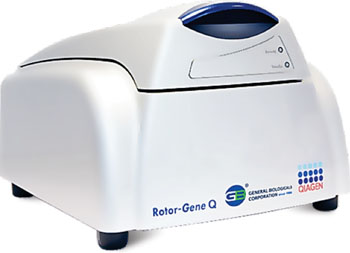Early Detection Identified for Leukemia Patients' Resistance to Therapy
By LabMedica International staff writers
Posted on 25 Aug 2016
A world-first breakthrough in the early detection of patients' resistance to a common treatment for chronic myeloid leukemia has been made. The discovery offers some hope that the patients' treatment could be changed sooner to improve their chances of survival.Posted on 25 Aug 2016
Tyrosine kinase inhibitor (TKI) therapy results in excellent responses in the majority of patients with chronic myeloid leukemia. First-line imatinib treatment, with selective switching to nilotinib when patients fail to meet specific molecular targets or for imatinib intolerance, results in excellent overall molecular responses and survival.

Image: The Rotor-Gene real-time PCR system (Photo courtesy of Qiagen).
A team of scientists led by those at the University of Adelaide (Australia) obtained peripheral blood from consenting patients before commencement of imatinib therapy (day 1) and at post-therapy time points specified in the TIDEL II (Therapeutic Intensification in DE-novo Leukemia II) protocol (for example, day 22, imatinib cessation). Patient cells were collected at time points defined in the TIDEL II treatment schema: total white cells were isolated by ammonium chloride lysis for determination of ATP Binding Cassette Subfamily B Member 1 (ABCB1) messenger ribonucleic acid (mRNA) levels and frozen, mononuclear cells were isolated from whole blood by Ficoll gradient.
Real time quantitative polymerase chain reaction was performed and amplified on a (Corbett Research, San Francisco, CA, USA). BCR-ABL1 mRNA expression levels were quantitated using the TaqMan Universal PCR Master Mix and the ABI Prism 7500 Sequence Detection System (Applied Biosystems, Foster City, Ca, USA). The team's work showed for the first time, that assessing a patient's levels of the P-glycoprotein soon after they start receiving Glivec therapy will help to predict that patient's long-term response to the drug.
The authors concluded that analysis of expression levels at diagnosis and after three weeks undergoing imatinib therapy (day 22) highlights the potential importance for monitoring increases in ABCB1 mRNA expression early in therapy to predict those patients likely to achieve poor molecular responses. An increase in levels of ABCB1 mRNA may serve as an easily translatable early warning assay for loss of response/development of resistance to imatinib.
Laura N. Eadie, PhD, the lead author of the study said, “Some patients were found to have higher levels of P-glycoprotein in their leukemic cells after just a few weeks of starting therapy. These patients were much more likely to develop resistance to Glivec later on. We've found the greater the increase in P-glycoprotein in patients, the greater their risk is of becoming resistant and not responding to their drug any more, or even succumbing to their disease.” The study was published on July 15, 2016, in the journal Leukemia.
Related Links:
University of Adelaide
Corbett Research
Applied Biosystems










 (3) (1).png)



